Abstract
In vitro accumulation ofp-aminohippurate (PAH) was investigated in “intact” human renal cortical slices of normal kidney tissue and in tissue slices of renal cell carcinoma (RCC). The technique used was established in preliminary experiments on rat kidney tissue slices. In principle, the accumulation capacity is comparable in renal tissue slices of both species (slice to medium accumulation ratios between 4 and 8). In man sex differences in accumulation capacity do not exist. But, as shown in detail for rats, accumulation capacity drops with age. Tissue slices of RCC are unable to accumulate PAH actively; slice to medium ratio reaches about 1 and indicates passive PAH uptake only. Surprisingly, in tumors of stage pTl PAH uptake is lowest, perhaps as a sign of PAH transport out of the cells. There is no difference between peripheral and central parts of RCC. Age and sex are without influence on PAH uptake in RCC tissue slices. Interestingly, the accumulation capacity of “intact” tissue of kidneys infested with RCC also depends on the severity of the tumor (stage, diameter), but not on grading and formation of metastases.
Similar content being viewed by others
References
Berlion M, Arvelo F, Leonce S, Bourgeois Y, Rigaudy P, Bizzari JP, Poupon MF (1993) Antitumor activity of the new vinca-alkaloid S 12363 alone or in combination with verapamil on a human multidrug resistant renal carcinoma xenograft. In Vivo 7:399–405
Bratton AC, Marshall EK (1939) A new coupling component for sulfonamide determination. J Biol Chem 128:537–550
Bräunlich H (1981) Excretion of drugs during postnatal development. Pharmacol Ther 12:299–320
Braunlich H, Pils W (1992) Synergistic effect of triiodothyronine and dexamethasone on renal tubular transport ofp-aminohippurate in rats of different ages. Dev Pharmacol Ther 19:50–56
Bräunlich H, Meinig T, Grosch U (1993) Postnatal development of sex differences in renal tubular transport ofp-aminohippurate (PAH) in rats. Exp Toxicol Pathol 45:309–313
Broxterman HJ, Pinedo HM, Kuiper CM, van der Hoeven JJ, de Lange P, Quak JJ, Scheper RJ, Keizer HG, Schuurhuis GJ, Lankelma J (1989) Immunohistochemical detection of P-glycoprotein in human tumor cells with a low degree of drug resistance. Int J Cancer 43:340–343
Chapman AE, Goldstein LJ (1995) Multiple drug resistance: Biologic basis and clinical significance in renal-cell carcinoma. Semin Oncol 22:17–28
Efferth T, Lohrke H, Volm M (1989) Reciprocal correlation between expression of P-glycoprotein and accumulation of rhodamine 123 in human tumors. Anticancer Res 9:1633–1637
Eliason JF, Ramuz H, Yoshikubo T, Ishikawa T, Yamamoto T, Tsuruo T (1995) Novel dithiane analogues of tiapamil with high activity to overcome multidrug resistance in vitro. Biochem Pharmacol 50:187–196
Fisher RL, Sanuik JT, Gandolfi AJ, Brendel K (1994) Toxicity of cisplatin and mercuric chloride in human kidney cortical slices. Hum Exp Toxicol 13:517–523
Fleck C, Kunze C, Braunlich H (1987) Relation between renal and hepatic excretion of drugs: V. Factors influencing accumulation of phenol red in kidney and liver tissue from rats of different ages. Exp Pathol 32:99–110
Fleck C, Haubold D, Hillmann T, Möckel H, Möckel M, Bräunlich H (1993) Evaluation of methods indicating higher susceptibility of immature rats to renal ischemia. Exp Toxicol Pathol 45:155–160
Focan C (1995) Circadian rhythms and cancer chemotherapy. Pharmacol Ther 67:1–52
Gottesman MM, Hrycyna CA, Schoenlein PV, German UA, Pastan I (1995) Genetic analysis of the multidrug transporter. Ann Rev Genetics 29:607–649
Hermanek P, Schrott KM (1990) Evaluation of the new tumor, nodes and metastases classification of renal cell carcinoma. J Urol 144:238–242
Klinger W, Müller D, Kleeberg U, Barth A (1983) Extrapolation von Tierversuchen auf Reaktionen beim Menschen. Pharmazie 38:621–623
Lai T, Collins CM, Hall P, Morgan AP, Smith PJ, Stonebridge BR, Symes MO (1993) Verapamil enhances doxorubicin activity in cultured human renal carcinoma cells. Eur J Cancer 29A:378–383
Licht T, Gottesman, MM, Pastan I (1995) Transfer of the MDR 1 (multidrug resistance) gene: Protection of hematopoietic cells from cytotoxic chemotherapy, and selection of transduced cells in vivo. Cytokin Mol Ther 1:11–20
Mickisch GH (1994a) Therapie des Nierenzellkarzinoms — Eine Aktualisierung notwendig? Akta Urol 25:77–83
Mickisch GH (1994b) Multidrug Resistance des Nierenzellkarzinoms — Von der Laborkuriosität zur klinischen Realität. Akta Urol 25:327–337
Mickisch GH, Merlino GT, Aiken PM, Gottesman MM, Pastan I (1991) New potent verapamil derivatives that reverse multidrug resistance in human renal carcinoma cells and in transgenic mice expressing the human MDR1 gene. J Urol 146:447–453
Naito S, Sakamoto N, Kotoh S, Goto K, Matsumoto T, Kumazawa J (1993) Expression of P-glycoprotein and multidrug resistance in renal cell carcinoma. Eur Urol 24:156–160
Nishiyama K, Shirahama T, Yoshimura A, Sumizawa T, Furukawa T, Ichikawa-Haraguchi M, Akiyama S, Ohi Y (1993) Expression of the multidrug transporter, P-glycoprotein, in renal and transitional cell carcinomas. Cancer 71:3611–3619
Okada S, Hamazaki S, Ebina Y, Li JL, Midorikawa O (1987) Nephrotoxicity and its prevention by vitamin E in ferric nitrilotriacetate-promoted lipid peroxidation. Biochem Biophys Acta 922:28–33
Palmer BF, Levi M (1996) Effect of aging on renal function and disease. In: Brenner BM (ed) The kidney, 5th edn. WB Saunders, Philadelphia, pp 2274–2298
Robsen CJ, Churchill BM, Anderson W (1969) The results of radical nephrectomy for renal cell carcinoma. J Urol 101:297–301
Skinner DG, Calvin RB, Vermillion CD, Pfister RC, Leadbetter WF (1971) Diagnosis and management of renal cell carcinoma. A clinical and pathologic study of 309 cases. Cancer 28:1165–1177
Stopp M, Bräunlich H (1975) Die Akkumulation vonp-Aminohippursäure und Zyklopenthiazid in Nierenrindenschnitten verschieden alter Ratten und ihre Abhängigkeit von der Energiebereitstellung. Acta Biol Med Germ 34:89–98
Stopp M, Bräunlich H (1980) In vitro analysis of drug-induced stimulation of renal tubularp-aminohippurate (PAH) transport in rats. Biochem Pharmacol 29:983–986
Volm M, Pommerenke EW, Efferth T, Lohrke H, Mattern J (1991) Circumvention of multi-drug resistance in human kidney and kidney carcinoma in vitro. Cancer 67:2484–2489
Author information
Authors and Affiliations
Rights and permissions
About this article
Cite this article
Fleck, C., Göckeritz, S. & Schubert, J. Tubular PAH transport capacity in human kidney tissue and in renal cell carcinoma: correlation with various clinical and morphological parameters of the tumor. Urol. Res. 25, 167–171 (1997). https://doi.org/10.1007/BF00941977
Received:
Accepted:
Issue Date:
DOI: https://doi.org/10.1007/BF00941977




